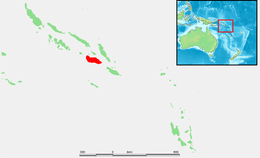Guadalcanal (Pacific Ocean island)
| Native name: Isatabu | |
|---|---|

Guadalcanal's position (inset) and main towns.
|
|
 |
|
| Geography | |
| Location | Pacific Ocean |
| Coordinates | 9°37′S 160°11′E / 9.617°S 160.183°ECoordinates: 9°37′S 160°11′E / 9.617°S 160.183°E |
| Archipelago | Solomon Islands |
| Area | 5,302 km2 (2,047 sq mi) |
| Highest elevation | 2,335 m (7,661 ft) |
| Highest point | Mount Popomanaseu |
| Administration | |
|
Solomon Islands
|
|
| Province | Guadalcanal Province |
| Largest settlement | Honiara (pop. 54,600 (2003 est.)) |
| Demographics | |
| Population | 109,382 (1999) |
| Pop. density | 20.4 /km2 (52.8 /sq mi) |
| Ethnic groups | Melanesian 93%, Polynesian 4%, Micronesian 1.5%, European 0.8%, Chinese 0.3%, other 0.4% |
Guadalcanal (indigenous name: Isatabu) is the principal island in Guadalcanal Province of the nation of Solomon Islands in the south-western Pacific, northeast of Australia. Its European discovery was under the Spanish expedition of Álvaro de Mendaña in 1568. The name comes from Guadalcanal, a village in the province of Seville, in Andalusia, Spain, birthplace of Pedro de Ortega Valencia, a member of Mendaña's expedition.
During 1942–43 it was the scene of the Guadalcanal Campaign, and saw bitter fighting between Japanese and US troops; the Americans were ultimately victorious.
At the end of the war, Honiara, on the north coast of Guadalcanal, became the new capital of the British Solomon Islands Protectorate. Guadalcanal is mainly covered in dense tropical rainforest and it has a mountainous interior.
A Spanish expedition from Peru under the command of Álvaro de Mendaña de Neira discovered the island in the year 1568. Mendaña's subordinate, Pedro de Ortega Valencia, named the island after his home town Guadalcanal in Andalusia, Spain. The name comes from the Arabic Wādī l-Khānāt (وادي الخانات), which means "Valley of the Stalls" or "River of Stalls", referring to the refreshment stalls which were set up there during Muslim rule in Andalusia. In the years that followed the discovery, the island was variously referred to as Guadarcana, Guarcana, Guadalcana, and Guadalcanar, which reflected different pronunciations of its name in Andalusian Spanish.
...
Wikipedia
